They're likely the most expensive thing you'll buy for your car, but how much attention do you pay to the little rubber donuts that go between your car and the road? Tires are one of the biggest factors affecting your performance, ride, fuel economy, and safety, but navigating through hundreds of choices can easily get overwhelming. The wrong choice can mean your truck can't haul, your sedan rides like a rock, or that your muscle car turns all of its V8 power into smoke. So here's the autoTRADER.ca guide to helping you pick the right tire for your vehicle and driving style.
How do you read a tire?

If you're not sure what size tire you need, many online tire retailers have a lookup tool. But to be sure, there's a sticker on your driver's door jamb that has all the important information. It should tell you the right pressures too, if you don't want to check your manual.
But what does that all mean? Starting with the first letter. It's either a P, which means it's a passenger car, but it could also read LT for light truck, T for temporary (like your spare tire), or ST for trailer. If there's no leading letter, treat it like a P.
After that comes the width of your tire, in mm. That's the approximate measured width of the tread surface. The next number is the sidewall height, as a percentage of the tread width. 185/75 means a tire that is 185 mm wide, with a sidewall that is about 139 mm (75 percent of 185) tall. R means radial construction, which has been the standard for road car tires for decades. The last number is the diameter of the wheel the tire will fit on.

After those, you might see two more numbers and a letter, like "97T" that's the load rating and speed rating of the tire. The door sticker will tell you the minimum requirement, but using a tire with a higher load or speed rating is fine. Using a tire with a lower rating is a bad idea. An overloaded tire could fail, leaving you stranded. Or worse.
The last bit of the puzzle is the treadwear rating. This is an estimate of how many kilometres you can expect the tire to last. The base tire used in the test is rated as a 100. A tire rated 300 should last three times as long as that base tire. A higher number is also normally accompanied by a longer treadwear warranty. Some buyers look at a lower number as meaning a tire with better grip, but that's not always the case.
What kind of tire do you need?

So now you know the basic specifications for the tire you need, but that doesn't narrow down the choices much. You still need to decide what type of tire you need before looking at brands or models. The basics are simple: if you have a car, you'll want a car tire. If you have a truck, you'll want a truck tire. If you're driving in winter conditions, you need a winter tire.
If you're looking for a car tire, there are a few categories. Apart from winter tires, there are basic all-season tires (also known as touring tires), slightly higher-performance tires labelled as performance tires or summer tires, and finally, there are high or ultra-performance tires. There is a broad range of tires in each category, but that's the simple look at it. If you drive an average sedan or coupe, you'll probably want a touring tire. Those tires will give you a softer, quieter ride, deliver longer life, and give good fuel economy. If you have a sportier car or one with higher horsepower, you'll want summer tires. If you have lots of power, a high-end sports car, or if you're planning some track time, then you'll want a high-performance tire. Those tires have more grip, especially in the dry, but may be noisier, harder riding, or wear more quickly.
If you have a truck, you'll need to decide if you want off-road performance or not. There are all-season truck tires, intended for on-pavement use, or all-terrain truck tires. All-terrain tires are just that, designed for mud, rocks, gravel, and dirt. They're not a substitute for winter tires. The aggressive tread that gives them grip off road can make them noisier on the road, so make sure to choose a tire for how you're going to use it.

SUV drivers have a tougher time. Many small SUVs and crossovers use car tires. They don't have the weight or carrying capacity to need anything heavier. Larger SUVs may come with big car tires, SUV tires, or truck tires. In this case, it might be best to speak with a tire professional to make sure you're getting the right rubber.
So once you've picked a category, how do you sort through all the marketing claims and pick a tire? Sticking with brands you've heard of is a safe bet, but online reviews are a good start. Sites like 1010tires and Tire Rack have ratings and thousands of reviews from professionals and buyers. They can narrow down to the category you want and then let you pick a tire. Once you find one you like, read the reviews and see if other people like the tires. Look for reviews from owners of vehicles similar to yours for best results. Replace tires in full sets whenever possible. On some all-wheel-drive cars it's absolutely necessary to do so in order to prevent damage to the all-wheel-drive system, but on all cars having equal traction at each corner improves safety and predictability.
If you're shopping for the cheapest price, and you see a price that looks too good to be true on a brand name you've never heard of, be careful. If a brand doesn't have a Canadian distributor, then the tire may not be available if you need a replacement. There may also be no company around to let you know if the tires have a safety issue and are recalled. If you can't find a Canadian website for the brand, then it may be best to move to a different tire.
But let's say you've read through all this, and still aren't sure what you need. No problem. That's what tire dealers are for. Bigger tire stores, chains, and good dealer service departments provide training for their staff to help them help you. Some even send their sales staff to events where they can try different tires themselves. Go to a tire store, tell them what you have, what your priorities are, and ask what they recommend.
What about after you buy?

Tires are probably the most expensive maintenance item your car will need. Take care of your investment. Consider tire protection or road hazard plans that cover against accidental damage or punctures. Some will also pay for repairs, or even provide roadside assistance. Make sure you keep them inflated properly. Get a tire gauge, and follow the recommendations on the tire sticker on the door jamb.
Check your air pressure. Tires can lose one or two psi per month. Underinflated tires wear and perform poorly, and they also use more fuel. Check your tire occasionally, or have them checked by an expert. Spotting odd wear patterns or damage as early as possible can increase safety and prolong the life of the tire.
If you want to keep that long treadwear warranty that your new tires came with, there are some things to remember. The first is that they are prorated warranties. If your tires are warranted to 100,000 km, and they last 60,000 km, then you don't get a new set. You'd get 40 percent off of a new set; plus you'll likely have to pay installation and balancing fees again.
But there are some other important things to consider. Most warranties have a recommended rotation schedule, with some requiring it to be performed by an authorized tire dealer. If the wear is caused by an alignment issue or improper inflation, then they won't be covered then either.
Finally, if you swap to winter tires when it gets cold [and you should – Ed.], make sure that you have documentation of the switch and the mileages, otherwise you won't get credit for kilometres driven with the winter tires.

